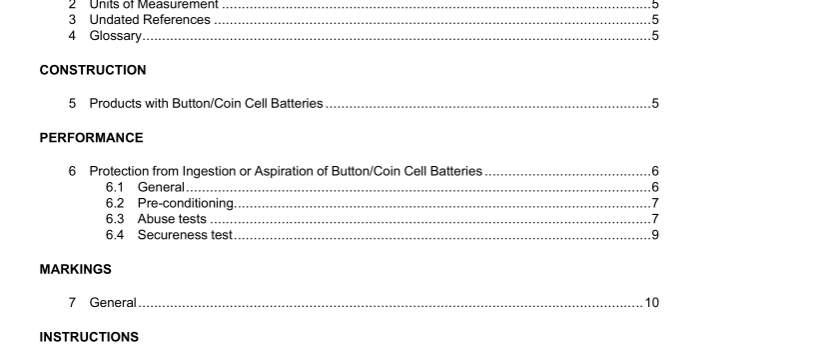UL 4200A-2020 pdf download.Products Incorporating Button or Coin Cell Batteries of Lithium Technologies.
5.3 The probe shall be applied to any depth that the opening will permit and shall be rotated or angled before, during, and after insertion through the opening to any position that is necessary to examine the enclosure. The probe shall be used as a measuring instrument to judge the accessibility provided by an opening, and not as an instrument to judge the strength of a material. The probe shall be applied with the minimum force necessary to determine accessibility. 5.4 During the examination of a product to determine whether it complies with the requirements in 5.3, a part of the enclosure that may be opened or removed by the user, either without using a tool or with less effort than two independent and simultaneous movements by hand, is to be opened or removed. 5.5 Products that locate removable or replaceable button/coin cell batteries inside a battery compartment shall be designed to prevent children from removing the battery by one of the following methods in (a) or (b) below. Compliance is checked by the tests of Section 6. a) A tool, such as a screwdriver or coin, is required to open the battery compartment. For a battery compartment secured by a screw or a twist-on access cover, a minimum torque of 0.5 Nm and a minimum angle of 90 degrees of rotation shall be required to open the compartment or the fastener shall engage a minimum of two full threads; or b) The battery compartment door or cover requires the application of a minimum of two independent and simultaneous movements to open by hand. 5.6 If screws or similar fasteners are used to secure the door or cover providing access to a battery compartment, the fasteners shall be captive to the door, cover, or device. Exception: This requirement does not applyto large panel doors on large devices which are not likelyto be discarded orleft offthe equipment.
6.2 Pre-conditioning 6.2.1 One test sample shall be subjected to the following pre-conditioning conditions in sequence prior to testing in 6.3 and 6.4, as applicable: a) Stress Relief Test – A product with an enclosure, battery compartment door/cover or battery compartment door/cover opening mechanism made of molded or formed thermoplastic materials shall be subjected to a stress relief test. A sample of the complete product is to be placed in a circulating air oven for a period of 7 h. The oven temperature is to be set to the higher of (1) or (2) below. After removal from the oven, the sample is permitted to cool to room temperature. 1) 70°C (158°F); or 2) 10°C (18°F) higher than the maximum temperature of thermoplastic enclosures, battery compartment door/covers, or battery compartment door/cover mechanisms during the most stringent normal operation of the device. b) Battery Replacement Test – The battery compartment door/cover shall be opened and closed, and the battery removed and replaced, for a total of ten cycles. The process shall simulate replacement according to the manufacturer’s instructions. If the battery compartment is secured with a screw (s), the screw (s) is to be loosened and then tightened by means of a suitable screwdriver, applying a continuous linear torque according to the Torque to be Applied to Screws table, Table 20, of the Standard for Audio, Video and Similar Electronic Apparatus – Safety Requirements, UL 60065.
6.3 Abuse tests 6.3.1 General 6.3.1.1 The tests in 6.3.2 – 6.3.4 shall be performed sequentially, as applicable, on one pre-conditioned sample of the product. After all test conditions have been completed, compliance is checked by 6.3.5. 6.3.2 Drop test for portable devices 6.3.2.1 Portable devices are subjected to drop tests from a height of 1.0 m (39.4 in) onto a horizontal hardwood surface in positions likely to produce the maximum force on the battery compartment or enclosure. Portable devices are subjected to three drops, except hand-held products are subjected to ten drops. The hardwood surface shall be at least 13-mm (1/2-in) thick, mounted on two layers of nominal 19- mm (3/4-in) thick plywood, placed on a concrete or equivalent non-resilient surface. 6.3.3 Impact test 6.3.3.1 The enclosure or battery compartment door/cover shall be subject to three, 2-J (1.5-ft·lbf) impacts. This impact is to be produced by dropping a steel sphere, 50.8 mm (2 inches) in diameter, and weighing approximately 0.5 kg (1.1 lb) from the height required to produce the specified impact, as shown in Figure 6.1, or the steel sphere is to be suspended by a cord and swung as a pendulum, dropping through the vertical distance required to cause it to strike the surface with the specified impact as shown in Figure 6.2. The steel sphere is to strike the battery compartment door/cover perpendicular to the enclosure surface.UL 4200A-2020 pdf download.
UL 4200A-2020 pdf download
